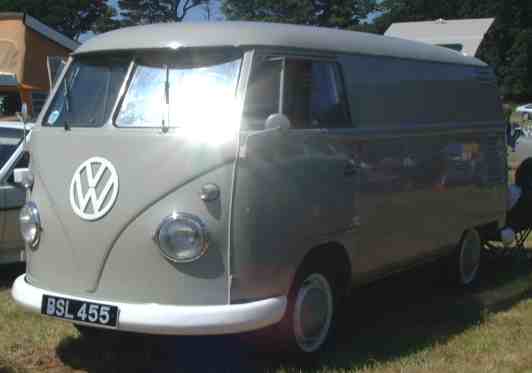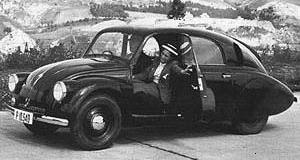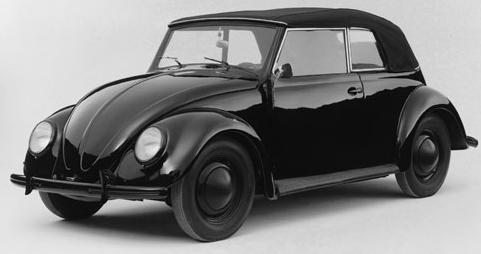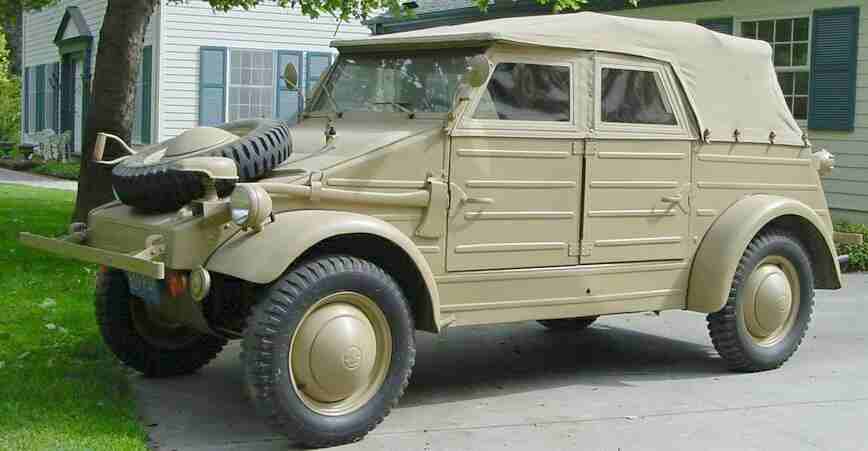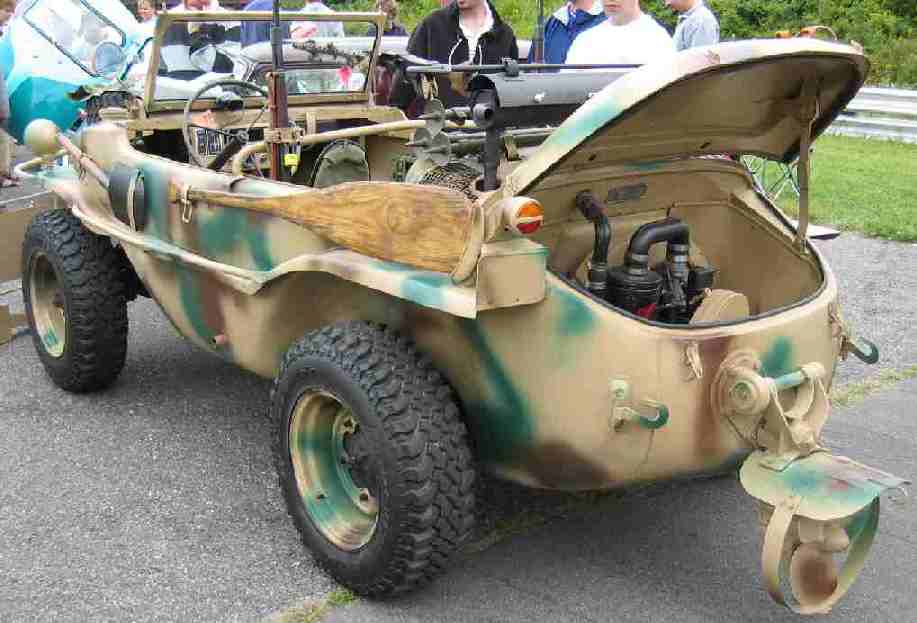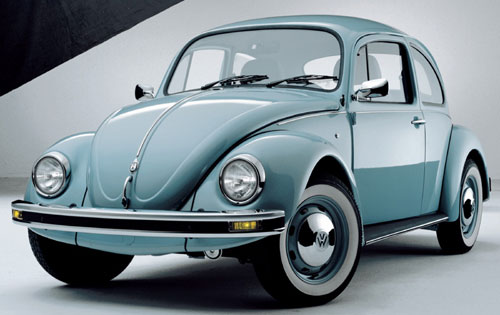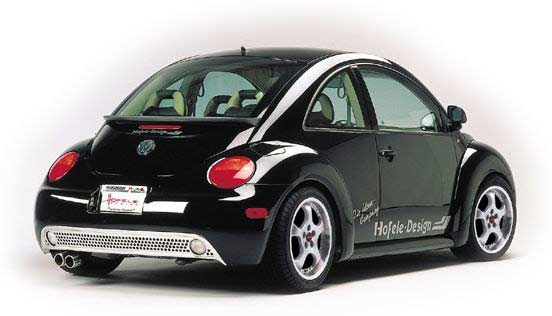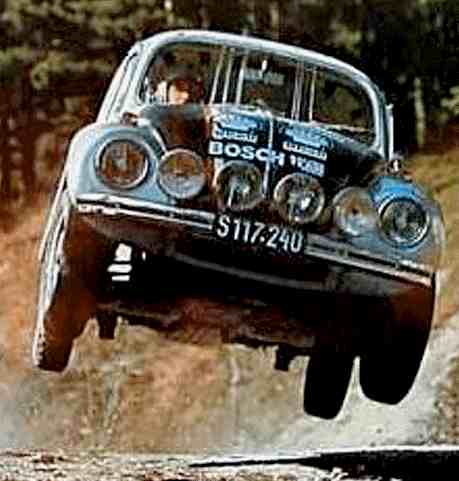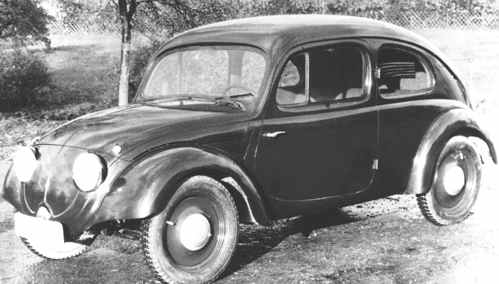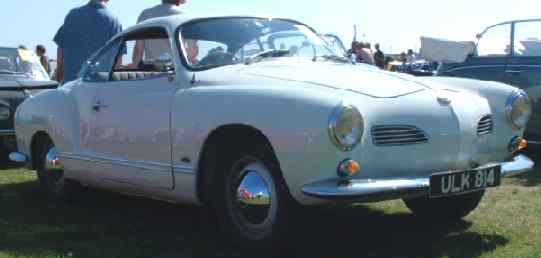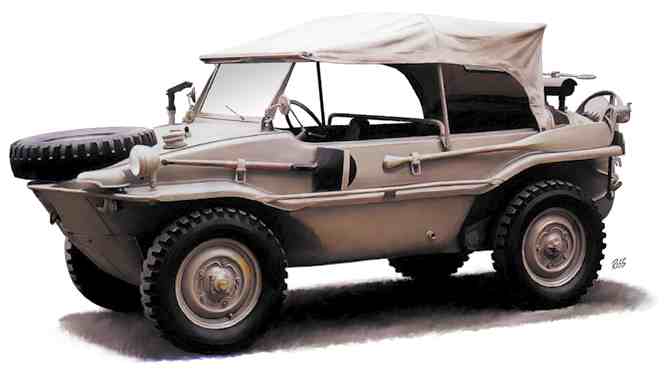|
The Volkswagen Beetle Car originated in Germany and is produced by the company Volkswagen. In German, Volkswagen means: People's Car. This Beetle has outsold every sort of car that has ever been made. It dates back to the early thirties and its history still grows as it continues to be produced. Production has now spanned over sixty five years and new technologies have been implemented along the way. Some of these are shown in the timetable below.
Split screen VW van
How The Beetle Began: In the early 1930's, Ferdinand Porsche and his company Dr.-Ing. h.c. Ferdinand Porsche GmbH designed a prototype of the Beetle Car. It was a streamlined sedan with a rear engine so that the driveshaft would be shorter, whilst the weight of the engine would still be distributed safely. This prototype was built by a motorcycle producer called Zundapp and test driven in 1932. It did not go into production though because Zundapp decided to keep making motorcycles as they were in high demand.
Ferdinand
Porsche was designing fantastic Mercedes touring cars and racers, long
before Hitler was elected to power in Germany, he was conjuring up schemes
to mass-produce an affordable car.
It
is a little known fact that Professor Porsche worked with electric
vehicles in the early 1900's. Porsche used a wheel motor in the hubs
to propel his vehicles and later when working with the Lohner company,
they produced four wheel drive electric vehicles. Later still
Professor Porsche worked with Mercedes on an electric hybrid vehicle,
where a petrol engine drove a generator which powered the electric
traction motors of the "Mercedes Mixt."
Tatra T97
Adolf Hitler at this time had a vision of his countrymen being able to own a cheap car and had plans on creating great networks of roads called autobahns. Hitler invited Porsche to submit to him a design for this peoples car, it had to be cheap, economical, fast (all of 60 miles per hour) and to accommodate two adults and three children comfortably. So, in January 1934 Porsche gave Hitler a proposal for his car and by June that year work had begun. Some funding was given by the RDA (Reichsverband der Autmobilindustrie - the German Auto Dealers Association), to help pay the bills!
The three 1936 prototypes didn't even have rear windows but this soon changed. By 1937 30 prototypes had come out of the factory and were tested for faults. In May 1938 Hitler laid the foundation stone of the Volkswagen Beetle GmbH factory at Fallersleben, near Hanover and he also had a town called Kraft durch Freude Stadt (this name comes from Hitlers motto "Joy through Strength") built for the factory workers. Hitler also decided that this new car of the people was also to be known as the KdF-wagen, (short for the "Joy through Strength" car).
Deliberately designed to be as simple as possible mechanically, there was simply less that could go wrong; the aircooled 985 cm³ 25 hp (19 kW) motors proved especially effective in action in North Africa's desert heat. A handful of civilian-spec Beetles were produced, primarily for the Nazi elite, in the years 1940-1945, but production figures were small. In response to gasoline shortages, a few wartime "Holzbrenner" Beetles were steam-powered with wood burning boilers under the hood. In addition to the Kubelwagen, Schwimmwagen, and a handful of others, the factory managed another wartime vehicle: the Kommandeurwagen; a Beetle body mounted on the 4WD Kubelwagen chassis. A total of 669 Kommandeurwagens were produced until 1945, when all production was halted due to heavy damage sustained in Allied air raids on the factory. Much of the essential equipment had already been moved to underground bunkers for protection, allowing production to resume quickly once hostilities had ended.
Volkswagen Cabriolet 1937
Much of the Beetle's design was inspired by the advanced Tatra cars of Hans Ledwinka, particularly the T97. This also had a streamlined body and a rear-mounted 4 cylinder horizontally-opposed air-cooled engine. Tatra sued, but the lawsuit was stopped when Germany invaded Czechoslovakia. The matter was re-opened after WW2 and in 1961 Volkswagen paid Tatra 3,000,000 Deutsche Marks. These damages meant that Volkswagen had little money for the development of new models and the Beetle's production life was necessarily extended.
The Volkswagen company owes its postwar existence largely to one man, British army officer Major Ivan Hirst (1916–2000). After the war, he was ordered to take control of the heavily bombed factory, which the Americans had captured. He persuaded the British military to order 20,000 of the cars, and by 1946 the factory was producing 1,000 cars a month. The car and its town changed their Nazi-era names to Volkswagen (people's car) and Wolfsburg, respectively. The first 1,785 Beetles were made in a factory near Wolfsburg in 1945.
Production of the "Type 1" VW Beetle (German: "Käfer"; US: "Bug"; French: "Coccinelle"; Italian: "Maggiolino"; Mexico: "Vocho"; Brazil: "Fusca"; Spanish: "Escarabajo"; Dutch: "Kever"; Portuguese: "Carocha") increased dramatically over the years, with the 1 millionth car coming off the assembly line in 1954. During the 1960s and early 1970s, innovative advertising campaigns and a glowing reputation for reliability and sturdiness helped production figures to surpass the levels of the previous record holder, the Ford Model T, when Beetle No. 15,007,034 was produced on February 17, 1972. By 1973 total production was over 16 million, and by 2002 there had been over 21 million produced.
Faced with stiff competition from more modern designs—in particular economical Japanese autos in the US—sales began dropping off in the mid-1970s. There had been several unsuccessful attempts to replace the Beetle throughout the 1960s; but the Type 3, Type 4), and the NSU-based K70 were all failures. Finally, production lines at Wolfsburg switched to the new watercooled, front-engined, front wheel drive Golf in 1974, a car unlike its predecessor in most significant ways.
Beetle production continued in smaller numbers at other German factories until 1978, but mainstream production shifted to Brazil and Mexico. The last Beetle was produced in Puebla, Mexico, in mid-2003. The final batch of 3,000 Beetles (officially named the Sedán in Mexico) were sold as 2004 models and badged as the Última Edición, with whitewall tires, a host of previously-discontinued chrome trim, and the choice of two special paint colors taken from the New Beetle. Production in Brazil ended in 1988, then restarted in 1993 and continued until 1996. Volkswagen sold Beetles in the United States until 1978 and in Europe until 1985.
Independent importers continued to supply several major countries, including Germany, France, and the UK until the end of production in 2003. Devoted fans of the car even discovered a way to circumvent US safety regulations by placing new Mexican Beetles on the floorpans of earlier, US-registered cars. The end of production in Mexico can be primarily blamed on the Mexican government's decision to gradually outlaw the use of 2-door cars as taxi cabs (the Beetle's core market in latter years.) In addition, Volkswagen, now Germany's largest automaker, has been attempting to cultivate a more upscale, premium brand image, and the simple Beetle, with its $7000 base price, clashed with VW's new identity, as seen in the Touareg and Phaeton luxury vehicles.
Like its competitors the Mini and the Citroën 2CV, the Beetle has been regarded as something of a "cult" car since its 1960s association with the hippie movement; and the obvious attributes of its unique and quirky design.
From 1968 to 2005 a white Beetle with racing numbers and stripes named "Herbie" played a starring role in The Love Bug series of Disney comedy films. A yellow Wunderkäfer, called DuDu, appeared in a series of German films for children. Also made famous is the Autobot Bumblebee/Gold Bug in the cartoon Transformers.
Kubelwagen
THE KUBELWAGEN
The Kubelwagen was the equivalent of the American Jeep during WWII. It was first designed by Dr. Ferdinand Porsche and by his son Ferry as a "buggy" for fun. With the war looming on the horizon, the "fun car" became a military vehicle.
The base is from the KDF (the future Volkswagen). Only the rear wheels are driven but the car is very light and behaves well in rough conditions.
One batch of Kubelwagens was supposed to have been shipped to the Russian front and another to North Africa. Ferry Porsche tells us in his book that because of a great deal of confusion, the cars manufactured for the cold climate (Russia) were shipped to Africa and, of course, the African cars were shipped to Russia!
Kübelwagen is an abbreviation from German Kübelsitzwagen which literally means "bucket seat car". It was a generic name for open-topped military utility cars fitted with bucket seats.
The word Kübelwagen is widely used in reference to the Volkswagen 82, a military version of the VW Beetle. The earlier prototypes had Porsche Type Number 62. Some numbers were built with 18 in road wheels but no reduction gears on the rear axle, a la Type 82. In its first incarnation about 52,000 were made before and during WW2 for the German military in the same factory as the Beetle at KdF-Stadt (Wolfsburg). It performed the role of the jeep for the Germans, but since it was only rear wheel drive (as opposed to four wheel drive) it did not perform as well off road.
Ferdinand Porsche did develop a four-wheel-drive version of the Kübelwagen. There were a few Type 86, a 4WD version of the Type 62 prototype, but then this was abandoned in favour of the Type 87, a 4WD version of the production type 82 (1941). Again, only a handful were manufactured (probably six, in Stuttgart, not Wolfsburg), but this vehicle is, historically important: it was the first Porsche-built car to have a 1086 cc engine. This engine featured the standard VW crankshaft, but with 73.5 mm (2.9 in) cylinder bores, and was later used in the Porsche 356.
The entire 4WD Kübelwagen project was abandonned in favour of the Schwimmwagen, type 128/166.
Schwimmwagen
THE SCHWIMMWAGEN
The VW-Schwimmwagen (Porsche Type 128 and Type 166) was an amphibious vehicle used extensively by the German Wehrmacht and the Waffen-SS during the Second World War. It was mechanically based on the Kübelwagen (which in turn was based on the civilian Volkswagen, later known as a VW Beetle), and was produced by the Volkswagen factory at Wolfsburg, with the bodies (or rather hulls!) produced by Ambi Budd in Berlin. Erwin Komenda, Ferdinand Porsche's first car body designer, developed the car body construction. Komenda patented his ideas for the swimming car at the German Patent office.
All Schwimmwagens were four wheel drive (even the earlier Type 128, based on the full-length Kübelwagen chassis (2.4 m (7.9 ft) wheelbase). The large-scale production models (Type 166) had a wheel-base of only 2.0 m (6.6 ft).
Finally, in April 1939 production started on the KdF-wagen but only 210 were made before World War 2 (1939-1945) disrupted the Western World and bombing ruined the factory.
During the War production ceased but by 1946, the 1000th Beetle Car had rolled out of the factory and the town of KdF had been renamed to Wolfsburg after Werner von Schulenberg of Wolfsburg who had been forced to give up his land for the building of the town and factory. This was a much simpler car than those we jump into today. Cars produced during 1946-1948 had a rear window with a split down the middle, so it was really two windows and indicators popped out from a space between the front and back doors. There was a rear brake light that looked suspiciously like a nose and the petrol tank was hidden under the hood - there wasn't even a petrol gauge, but there was a speedomoter!
From 1945-1947 the British Military ran the factory before handing it back to Germany in 1948. By the end of that year nearly a quarter of the Beetles produced were exported, mainly to Europe. This was just the beginning for the Beetle Car's international trip to fame.
PHASING OUR THE ORIGINAL BEETLE
In 2002 total production of the VW Golf, at 22 million units, overtook that of the Beetle. However this measure includes all four distinct generations of Golf since 1974, and these are really different cars using the same name, as is also the case with the Toyota Corolla.
Production
of the Beetle continued for Europe and the rest of the world at a plant in
Puebla, Mexico. In 1981 the 20 millionth Beetle popped
off the Puebla line and headed straight into a museum.
Some 65 years after its public launch in Nazi Germany, and an unprecedented 58-year production run since 1945. VW announced this step in June, citing decreasing demand.
The last car was immediately shipped off to the company's museum in Wolfsburg, Germany. In true Mexican fashion, a mariachi band serenaded the last car. The final edition had the following specifications:
New watercooled FWD Beetle
THE NEW BEETLE
At the 1994 North American International Auto Show, Volkswagen unveiled the Mays-penned "Concept 1", a concept car with futuristic styling deliberately reminiscent of the original Beetle's rounded shape. Strong public reaction convinced the company to move the car into production, and in 1998 Volkswagen launched the New Beetle, designed by Mays and Freeman Thomas at the company's California design studio.
The New Beetle is related to the original only in name and appearance: under the hood, it is a modern car in every way, based on the Volkswagen A platform. In stark contrast to the original, the Insurance Institute of Highway Safety gave the New Beetle among the best safety ratings in its class at the time of its launch.
Marketing campaigns have enhanced the continued goodwill towards the original, and helped the new model to inherit it. The Volkswagen New Beetle was Motor Trend's Import Car of the Year for 1999.
The Life Story of Professor Dr. "Ferry" Porsche
Although the company of Dr. Ing. h.c.F Porsche AG was formed on April 25, 1931 as "designers and consultants for land, sea and air vehicles," it was Professor Dr. Ferry Porsche, son of the automotive genius Professor Ferdinand Porsche, who steered the company into becoming one of the world's leading automotive engineering design companies and specialist manufacturer of sports cars. From the time he designed the first Porsche, the Type 356 in 1948, it was his personal involvement that made Porsche the great marque it is today.
When Ferdinand Anton Ernst Porsche, known as "Ferry," was born in Wiener Neustadt, Austria, on September 19, 1909, his father was Technical Director of the Austro-Daimler Company. Never far away from the automotive work of his father, Ferry Porsche was soon behind the wheel of a car and, by the age of twelve, was even permitted to run in the class winning Targo Florio car, the lightweight Austro-Daimler Sascha.
When the Porsche family moved to Stuttgart in 1923 for Professor Ferdinand Porsche to become the Technical Director of Daimler-Benz, the south German automotive center became Ferry Porsche's second home. It is there that he was educated and met his wife, Dorothea, she remained his staunch companion until her death in 1985, and was the mother of his four sons.
Ferry Porsche started working with his father when the latter formed his independent design office. Their first contract, designated number 007 to give the impression it was not their first project, was a 2-liter car for Wanderer. The success of this car was later to lead the newly founded Auto Union Company, which had incorporated Wanderer, to appoint Professor Porsche as the designer of a new Grand Prix car to meet the new 750 kgs. maximum weight formula.
Volkswagen racing
The Auto Union was the most advanced pre-war racing car design concept. It was of lightweight construction, featured a 16-cylinder super-charged engine, with unique valve control mounted just behind the driver; an engine position which is standard for all modern generation F1 cars. Ferry Porsche played no small part in its design and construction. Less well known is the fact Ferry Porsche conducted much of the initial test driving of the car until his father declared one day, "I have enough drivers, but only one son."
One other car which the Porsche firm designed before World War II was to have an important influence on both Ferry Porsche and the rest of the world. It was, of course, the most produced car of all time: the Volkswagen Beetle.
The war itself cut deep into the life of the young automobile designer. Transferred from demolished Stuttgart to the Carinthian town of Gmund in 1943, Ferry Porsche and a few colleagues had to start again from scratch in 1945 by keeping busy with repair jobs and the construction of simple farm machinery.
Meanwhile, the French held Ferry's father, Professor Ferdinand Porsche until 1947, when Ferry Porsche's family managed to raise sufficient money from new contracts in Italy to buy his freedom. One of these design projects resulted in the Cisitalia Formula 1 race car, unveiled at the Turin Motor Show that same year. It was the first race car with a midmounted engine and four-wheel drive.
After that, Ferry Porsche decided to build his own sports car, effectively the first "Porsche." He took out plans he made back in 1939 for a light, compact car based on the Volkswagen, practically the only components available in Germany at the time. Besides providing speedy acceleration, unmatched braking and good road holding, an essential criterion was the car had to be practical for everyday use. Its "marketing concept" adopted by Ferry Porsche was, "If I build a car that gives me satisfaction, then there must be others with the same sort of dreams who would be prepared to buy such a car."
The first car to bear the Porsche name, the Type 356, was delivered on June 8, 1948. It boasted a tubular space frame chassis, an aluminum body and a rear-mounted four-cylinder 1.131 cc VW engine. The following year, in order to ensure continued production of the 356, Ferry Porsche negotiated a new contract with the then head of Volkswagen, Heinz Nordoff, for the supply of parts. Besides this, the contract appointed Dr. Ing h.c.F Porsche K.G. as consultant engineer to VW, sole importer of VW's for Austria and recipient of a royalty sum on every VW Beetle produced at Wolfsburg.
A total of fifty-two 356 cars were built at Gmund in Austria before the company returned to Stuttgart. Production recommenced there in March 1950. During the same year, Porsche began designing its own engine, the Carrera. The 356 model, which was initially forecast to have a world sales potential of 500 units, was last produced in 1965 after over 78,000 cars had been built. The policy of model longevity is continued today with the Porsche 911, which enters its 35th year of production.
Volkswagen prototype
Professor Dr. Ferry Porsche was happy and grateful that his father witnessed with approval, shortly before he died on January 30, 1951, the start of Porsche as a specialist sports car manufacturer. Since 1948, decades of hard, dedicated work were put in by him to further enhance the Porsche product, which enjoyed a fine reputation from the beginning, by expanding customer service and marketing, not to mention accelerating product development through motor racing.
Since entering Le Mans in 1951 and achieving a class win, the name Porsche has been synonymous with success in motor sport. Amongst its numerous triumphs, Porsche has been crowned World Endurance Champion in sports car racing 14 times and, since 1970, has won the Le Mans 24-hour race a record 15 times. The world famous Monte Carlo rally was won four times by Porsche 911s, and an experimental 4WD 911 Carrera won the 1984 Paris-Dakar desert race first time out, the very first sports car ever to achieve this honor. Subsequently in 1986, Porsche 959s finished first, second and sixth on their debut outing in the event as well as becoming the first all-wheel drive racing car to enter and win its class at Le Mans.
In all, Professor Dr. Ferry Porsche demanded a great deal from his engineers, mechanics and drivers. He made courageous investments in new developments and thereby founded the worldwide reputation of his firm as a privately controlled, independent producer of technologically advanced sports and racing cars for worldwide use.
In 1972, the year the Porsche family withdrew from active management of the company, Weissach was opened. Today, Weissach is world famous as a site for research and development, where 30%, of all work is undertaken on behalf of other manufacturers, governments and NATO.
Back in 1965, Ferry Porsche was awarded an Honorary Doctorate by the Technical University of Vienna in recognition of his achievements in so many branches of the automobile world. In 1984 on his 75th birthday he was awarded the honorary title of 'Professor.'
Karman Ghia - based on Beetle floorpan & engine
BIOGRAPHICAL NOTES: PROFESSOR DR. ING. H.C.F PORSCHE - (1909-1998)
1909 Ferdinand Porsche was born in Wiener Neustadt, Austria on September 19. 1931 Began his activities as a designer in the engineering consultancy of his father, Dr. Ing h.c.F Porsche KG. 1932 Ferdinand Porsche's duties expanded to include supervision and coordination of testing. Assisted with the design and development of the Auto Union race car. 1934 Head of VW Testing 1935 Ferdinand Porsche became the Manager of the Research Department in the newly established Porsche test plant, Stuttgart-Zuffenhausen. 1935 Married Dorothea Reitz from Stuttgart (died 1985). They had four sons. 1938 Head of Development Department. In same year the design studio moved to a newly built building in Stuttgart-Zuffenhausen. 1940 Took over the post of deputy director for the entire operation. 1945 Ferdinand Porsche headed the firm, moved to Gmund in Carinthian during the war, and initiated development of the legendary Porsche 356, based on the Volkswagen and the first car to carry the Porsche name. 1948 The first 356 was completed in June. 1949 After completing the first 52 cars of this 356 range, Ferdinand Porsche with his company and most of his colleagues returned to Stuttgart-Zuffenhausen. Rebuilding of the consultancy offices for outside contracts took place. 1950 Production of the Porsche 356 began in Stuttgart-Zuffenhausen. 1959 Professor Theodor Heuss presented the Grosse Verdiensstkreuz (Commander's Cross of the Order of Merit) of the Federal Republic of Germany to Ferdinand Porsche in September. 1965 The Technical University of Vienna honored Ferdinand Porsche in November with the presentation of the title, Dr. techn. E.h. 1972 The Dr. Ing. h.c.F Porsche KG became a joint stock company (AG). Dr. Ferdinand Porsche assumed the post of Chairman of the Supervisory Board. 1975 Dr. Porsche received the Grosse Goldene Ehrenzeichen (Great Golden Cross Of The Order Of The Order Of The Order Of the Order of Merit) of the Republic of Austria in Vienna on January 31. 1979 On September 19, Lothar Spath, Prime Minister of Baden-Wurttemberg presented Dr. Porsche with the Grosse Verdienstkreuz mit Stern (Knight Commander's Cross) of the Bundesverdienstorden, on the occasion of his 70th birthday. 1984 A third of the entire Dr. Ing. h.c.F Porsche AG capital was offered to the public in the form of non-voting preference shares on April 25. On September 19, Dr. Ferry Porsche celebrated his 75th anniversary and was awarded the honorary title of 'Professor.' 1985 The Guild of Motoring Writers Vice Presidents trophy for outstanding achievements in the field of automobilism was won by Professor Dr. Ferdinand Porsche. Honor of "Senator E.h." by University of Stuttgart. 1990- 1998 Honorary President of Supervisory Board, Porsche AG.
Please click on the links above to find out about these famous automotive makers. If your company is not included and you would like to be listed, please let us know.
Solar Cola sponsor this website
|
||||
|
The
content of this website is copyright © and design copyright 1991 and
2006 Electrick Publications and NJK. All rights reserved. The bird |
||||
